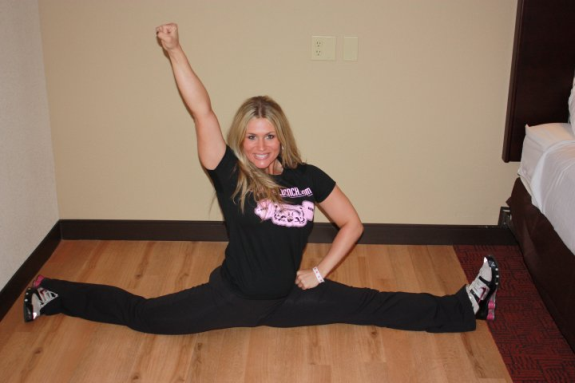Were We Made To Run, Not Walk? (Part 1)
by Shin Ohtake creator of Max Workouts

To run or to walk? Which is the preferred method of travel? Most of us would probably pick walking. It's low impact, easier, and although it takes longer, most of us can walk for much longer distances before we run out of gas. But what if I told you that our bodies are designed to run, not walk? According to a study done by University of Utah biologist Dennis Bramble and Harvard University anthropologist Daniel Lieberman, we evolved from more ape-like human ancestors that survived due their ability to run longer distances for hunting animals and scavenging carcasses-and it's what shaped our anatomy. This theory goes against the popular long standing theory of bipedalism, which states that we evolved to walk first and that running was just a simple byproduct. Dennis Bramble and Daniel Lieberman state that some of the most compelling evidence comes from our own anatomy.
- A ligament that runs from the back of the skull and neck down to the thoracic vertebrae, and acts as a shock absorber and helps the arms and shoulders counterbalance the head during running.
- Unlike apes and australopithecines, the shoulders in early humans were "decoupled" from the head and neck, allowing the body to rotate while the head aims forward during running.
- The tall human body-with a narrow trunk, waist and pelvis-creates more skin surface for our size, permitting greater cooling during running. It also lets the upper and lower body move independently, "which allows you to use your upper body to counteract the twisting forces from your swinging legs", Bramble says.
- Shorter forearms in humans make it easier for the upper body to counterbalance the lower body during running. They also reduce the amount of muscle power needed to keep the arms flexed when running.
- The connection between the pelvis and spine is stronger and larger relative to body size in humans than in their ancestors, providing more stability and shock absorption during running.
- Human buttocks "are huge", says Bramble. "Have you ever looked at an ape? They have no buns". He says human buttocks "are muscles critical for stabilization in running" because they connect the femur-the large bone in each upper leg-to the trunk. Because people lean forward at the hip during running, the buttocks "keep you from pitching over on your nose each time a foot hits the ground".
- Long legs, which chimps and australopithecines lack, let humans to take huge strides when running, Bramble says. So do ligaments and tendons-including the long Achilles tendon-which act like springs that store and release mechanical energy during running. The tendons and ligaments also mean human lower legs that are less muscular and lighter, requiring less energy to move them during running.
- Larger surface areas in the hip, knee and ankle joints, for improved shock absorption during running by spreading out the forces.
- The arrangement of bones in the human foot creates a stable or stiff arch that makes the whole foot more rigid, so the human runner can push off the ground more efficiently and utilize ligaments on the bottom of the feet as springs.
Interesting, right? Well, before we get deeper into trying to answer the question, it's necessary for us to take a look at some facts about running.
A recent survey stated that there's approximately 30 plus million runners in the U.S. and about 10 million or more run at least 3 times per week. And amongst the runners that run approximately 3 times per week or more, up to 65% of them suffer some type of running related injury each year. The exact reasons are hard to pin-point, but here are some major contributing factors: 
- Distance - The higher the mileage the higher the incidence of running injuries
- Change in Running Program (poor training) - A sudden increase in the distance and/or intensity has been strongly linked with sustaining injuries
- Poorly fitting running shoes
Now, here's something really interesting: I recently came across a book called "Born to Run: A Hidden Tribe, Superathletes, and the Greatest Race the World Has Never Seen" by Christopher McDougall. The author of the book was inspired to write it when he saw a picture of an Indian Tribesman carrying a trophy after winning one of the most challenging 100 mile ultra-marathon races in North America-and he wasn't wearing any shoes, just a pair of hand made leather shods (sandals). Being an avid runner himself who had suffered from years of frustrating running injuries, he became intrigued by the picture and wanted to learn more about this man who was able run 100 miles without shoes and win against the most elite endurance athletes in the world. In writing this book he discovers that the man in the picture is part of a reclusive Tarahumara Indian tribe that resides in one of the most impenetrable terrains in northern Mexico, the Copper Canyons. Shielded from the hazards of stress and disease that plague our modern society, the Tarahumara Indians have no history of any diseases, no cancer, no heart disease... nothing. He also discovered that they have an amazing ability to run hundreds of miles without stopping, without shoes and with no incidence of injuries-and they run every mile with sheer elation.
How is it that the Tarahumara Indians are able to defy all of the major contributing factors that cause running injuries (high mileages, poor training, and improper shoes)? The Tarahumara Indians run on the balls of their feet.
Think about it, it makes sense right? The vast majority of people are heel strikers. If you don't have shoes how do you run? Try it out and the answer becomes immediately obvious. If you ran barefoot like you normally would with with shoes, you would crack your heels! Your heels just don't have enough padding to protect you, so to avoid hurting your heels you'd run on your toes or the balls of your feet. Long before there were any shoes, our first Olympians competed and ran barefoot. Even the famed marathon was run barefoot. And in order to do so it would only make sense that they were running on the balls of their feet as well.
If that was the case, it throws a big wrench into our entire perceived notion about running mechanics. That would mean that heel-to-toe running is incorrect and that you should not strike your heels when you run.
Barefoot running vs. modern running shoes
As foreign as it may seem to you, there's actually quite a large population of runners that have already discovered this and have changed their entire running mechanics so that they run without heel striking. Some of the more popular types of forefoot running techniques include the Pose Running and Chi Running methods. Each is slightly different in technique, but both promote the notion the natural running does not involve heel striking. Most of the people that have gone through this transition in running technique did so due to injuries that they incurred from running, and have since been injury free.
According to these forefoot running enthusiasts, the occurrence of popular running injuries such as plantar fasciitis, achilles tendonitis, patello femoral tendonitis, etc... all started to happen with the introduction of modern running shoes. Is it possible that what we put on our feet is what changed our ability to run correctly, and hence cause all these injuries? It does pose a couple of questions - why do all modern running shoes have such thick and cushioned heels, and how come none of these highly technologically advanced high-priced running shoes that claim to stabilize your feet and enable you to run more comfortably and efficiently, haven't curbed the rate of running injuries? Yet people like the Tarahumara Indians can run for hundreds of miles without shoes and sustain no injuries. It definitely makes you wonder...
Perhaps the Tarahumara Indians were not only sheltered from the harmful diseases that plague modern society, but their lack of exposure to the conveniences of modern civilization enabled them to keep one of our most basic human survival tools-running-untainted and perhaps true to our born ability. If that's the case, perhaps Dennis Bramble and Daniel Lieberman are correct. Maybe we were born to run. If that's so, when and how we lost our way is not completely clear. Did the invention of modern running shoes really alter our evolutionary progress? Whether it's the shoes or our innate need to pursue comfort and convenience that has caused us to be lazy, it's apparent that our "innate" ability to run has been compromised and if you suffer from nagging injuries that has taken the joy out of running, perhaps it's time you took a look at what's on your feet and try giving them a chance to do their job naturally-I'm talking about going barefoot.
How to run barefoot without actually being barefoot
Whether your an avid runner or just getting your cardio in on the treadmill, if you're weary of going barefoot, one of the best products out there today that allows you to experience being barefoot without actually being barefoot, is a product called Vibram FiveFingers. They're shaped just like your feet, separate toe compartments and all. The idea behind them is that all of the small intrinsic muscles in your feet are activated, allowing for better proprioception which enables you to move better by being more conscious. Admittedly, these shoes are not the prettiest things you've ever seen (quite far from it, actually), but they're probably the best way to re-learn how to walk and run the way we were born to.
I've been forefoot running for many years now (although, not barefoot...yet!), so stay tuned for Part 2 of this article where I'll show you the mechanics behind this method. I'm also going to demonstrate with the Vibram FiveFingers shoes.
Shin Ohtake is the author of the world-famous fitness program, MAX Workouts. To learn more about how you can get ultra lean and toned with shorter workouts, visit http://www.MaxWorkouts.com
More Articles By Shin Ohtake
Return to the Workout Articles Archive
|